Seymour Jacklin's Blog, page 4
September 2, 2015
How jazz shaped my philosophy of life
I’m not alone am I? I mean, most guys in their thirties … with a waistline you don’t want to be reminded of, and a knee-jerk cynicism about the world … most guys are wondering what happened to that little boy they once were: his focus, his energy, his passion, his fundamental optimism … his innocence?
A mid-life crisis? It’s basically a second adolescence where the question has changed from ‘who do I want to be?’ to ‘who have I become?’
There are a few things that make me feel sixteen. One of them is swimming in open water, another is listening to jazz, old jazz, New Orleans jazz from the early 20th century. That’s essentially the sound-track of my teens.
How do you rebel in a world of non-conformists?
It’s a strange choice, but honestly it was about the only avenue left open to express my rebellion, while I was trying to be a non-conformist like everyone else. My peers were listening to Nine Inch Nails, Portishead, House of Pain, Iron Maiden, Guns N’ Roses. My family (and music teachers) listened to baroque and classical music. Even the lefty teachers listened to New Model Army and The Levellers. I got captivated by the energy and optimism of jazz, and later found in it a voice for the melancholia and rebellion I treasured in my adolescent heart.
I started out taping jazz radio programs on BBC Radio 3. I ended up collecting photos of jazz musicians, reading every scrap of jazz history I could find and spending my breaktimes on a piano in the music school. This music became one of my earliest mentors and I’m only discovering now how much it set my expectations and shaped my outlook. That boy I once was is still fundamentally running the show from speakeasy in the back of my mind.
Freelancing is the highest form of employment
For instance, I don’t think I’ve ever questioned my assumption that freelancing is the highest form of employment. I learned this from my trumpet-blowing heroes. At the end of the day, they had themselves, they had souls and a horn to blow it out from. They pitched up, they did their thing, then they disappeared back into the night, beholden to nobody. If they were good, they got booked; if they weren’t hot enough, they got cut. If they got into self-destructive habits, they burned their career, because they were inseparable from it.

Gentlemen prefer banjos
That’s it, you know, these musicians stood or fell on the basis of something that it was quite impossible to fake. You can paint jazz by numbers, and I’ve heard plenty of these guys who have emerged from conservatories who can run up and down scales very prettily — but the elusive elements of soul, swing and hotness … sticks out a mile.
Of course I’m romanticising it – but it’s the myth that wired me to be a freelancer.
I have no idea what’s going to happen, and I love it
Then there’s my almost-pathological preference for spontaneity. My heroes were (and still are) improvisers. None of them would pitch up to a jam session and ask to see the score, or dream of showing up with a bunch of pre-rehearsed licks. They’d internalised the outer forms and the inner core of their art a long time before they stepped up to the mic.
I can’t see the problem with going by the seat of your pants as long as, you know, you made those pants yourself, you know they are up to the job, and you carry a sewing kit in case they get torn
I still believe that you’ve gotta be a sponge and soak in stuff, so when you get poked that’s what comes out. If it’s not in you already, it’s too darn late to start preparing now. Being an improviser isn’t about not being prepared, it’s about the preparation happening over years in the past.
Individualism can coexist with collectivism
Then take the matter of ‘teamwork’, ‘leadership’ and all those buzz words you’ll never find on the sleeve notes of a hot record. My take on these tings is still cast acccording to the loose categories of ‘ensemble’, ‘soloist’ and ‘bandleader’.
The feature that makes early New-Orlenian jazz so special compared to what followed is the ‘ensemble’. Everyone plays together – everyone improvises together. It’s not about the solos, like it is today. You might not hear any solos; sometimes the most a single instrumentalist gets to play in the limelight is a four-bar break to key the ensemble back in.
The phenomenon of a band leader is an interesting one in this egalitarian context. From my reading of early jazz history the bandleader is:
needed by the entertainment industry so they have a name they can use to sell records and attract the punters (‘Jelly Roll Morton’s Red Hot Peppers’ is going to sell better than ‘some guys with horns and stuff who happened to be available on Friday afternoon’)
the one with the personal influence, the network and the contacts (in modern business terms) to convene an assortment of seasoned musicians who are going to sound good together (the cats dig him/her enough to pitch up)
someone who has to take care of that client-facing stuff, you know, and make sure everyone gets paid if they’ve been sober
None of that means the band leader is any kind of big-shot when it comes to the team performing (or the band playing).
Classic New-Orleans jazz is a shining example of how both individualism and collectivism can play loud and strong together in society. I guess I’m holding out for that.
That’s almost enough said … yup, enough. I’ll just let the music speak for itself. This is Black Bottom Stomp (it still raises the hairs on my neck):
Filed under: Inspiration, Music Tagged: Audio, Freelancing, Jazz, Nostalgia


August 14, 2015
“True voice” blogging
So, I recently found a great website. I think that’s a rare event. More than half my time online is spent sifting irrelevant information and wincing at bad copy. I don’t say that to set myself up as a discerning arbiter of good taste – I do as much wincing when reading back over this blog as anywhere else.
HighExistence is on a mission to:
Provide a medium for freethinking individuals to connect & discuss
Compel you to follow your bliss & make a life, not a career
Explore all aspects of the human condition
Question anything & everything that is considered ‘normal’
Promote the general spread of happiness and love
That sounds like an invitation for every crackpot theorist to dive in and fill our screens with the kind of misspelled and vacuous user-generated content that we spend our lives clicking away from. But, like Reddit, HE has an upvoting system for posted items, and it works. Plus, it looks like a bit of vetting goes on before you become a contributor (known as a HEthen).
The platform seems to have become a good place for reading about folks who are taking an experimental approach to life, with themselves as the lab-rats. That’s the kind of stuff I can’t stay away from because, just like everyone else adventuring on the seas of post post-modernity, I’m always obsessing over the grand question of ‘how to live’.
Anyway, there was an article there titled “The Complete Guide to Not Giving a Fu@!<“. I thought, “I’m going to read this but I’ll not be sharing it with my network because it has swears in it.” In one sense the article is a shameless tid-bit of click-bait, but I found, for once, I didn’t click away with a sense of “there’s five minutes of my life I’ll never get back”.
It wasn’t the content (generic self-help chat you’ve probably heard before) that kept me reading , it was the style.
I’ve seen stuff a bit like it before. You might describe it as “true voice”, a little bit “stream of consciousness”. On the surface that’s exactly the type of rubbish I want to sift out. I get hired to straighten out people’s words, and I sometimes feel I’m in a lonely battle to get the world to, you know … use sentences.
However, I have to admit to noticing that the stuff that gets upvoted and read is seldom written in proper sentences and often commits grammar crimes.
I’ve seen it in countless non-fiction bestsellers on Kindle. It’s a conversational, ‘true voice’ chat style that could easily have been written in an afternoon by somebody using voice recognition software as they drove in their car, or lounged in the bath.
There are still plenty of inane anecdotes and rambling passages of thought out there. I mean, when will cookery bloggers learn that I’m there for the recipe and I’m skipping the six paragraphs where you gush about when and where you first tasted this dish and how delicious it was, and where your quest for the perfect ingredients took you next?
I’m not talking about that. But there really is a place for the uber-conversational style, when a writer really has something to say. In fact, it’s more engaging.
I’ve been on a bit of a journey in this blog’s five-year lifespan. The way I read and write now has changed, but I still cling to a more ‘literary’ feel on here.
I’ve blogged far less in the last couple of years. I think this is because:
having a sense of the blog as a ‘shop window’ has limited what I dare to put in it
writing it has started to feel too much like work
I’ve been very busy
it feels like I’m in a rut with my writing style here and I’m bored with my own voice
I’m overwhelmed with ideas for posts because I have too many interests
some of my energy is going into writing a book that is becoming a receptacle for a lot of what I’d probably be blogging about
So (and it’s okay to start a sentence with ‘so’) I’m hoping to shift things a bit and make posting more fun for me. Maybe this is a place where I can be a bit freer from the restraints of ‘professional’ writing.
Taking a leaf out of the ‘true-voice blogger’ book feels worth a try.
It’s time to break a few personal rules like this post does. Not only have I abandoned proper sentences but I’ve also posted one of those cringing self-conscious blog posts that ends up talking about the blog and what I’m going to write, instead of actually writing it.
Time to sign off for now.
Filed under: Blogging, Contemporary Culture, Inspiration, Writing Tagged: Social media, Writing


July 21, 2015
Going to a writer’s group in Second Life
About a month ago, I logged back into Second Life for the first time since 2007, when I’d signed up an account to see what all the hype was about. Back then, I’d spent a couple of hours staggering around and crashing into things with a ridiculously proportioned (and shirtless) avatar. As I recall, in those hours I did discover the avatar could walk under water and fly, and I did end up in a remote shrine that someone had built to a deceased loved one … then I checked out.
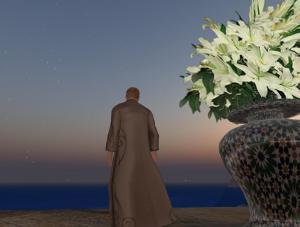
Enjoying a virtual sunset from the Church of the Dawn Treader
Second Life is a virtual world, mediated by a 3D rendering machine like that used for immmersive console games. Everything in it is built by users, so it represents a vast, interactive and habitable canvas of human imagination. Virtual items (from houses to body shapes, furniture, clothing and hair and scripts to make your avatar move in a certain way) can be bought with virtual currency (Linden) that has real-world equivalence.
I’ve very little experience of 3D computer games, finding them quite dull. Every time I’ve been persuaded to pick up a controller and race around a virtual racetrack or shoot things, I’ve wanted to drive to the mountains in the distance to get a closer look. As I found, you can’t do this in most games. However, you can in second life.
The learning curve for someone who is not familiar with virtual reality (VR) environments is very steep and if you’re a noob, it’s obvious. The two big time sinks at the outset are adapting and outfitting your avatar, so it doesn’t look generic, and learning to control the avatar and virtual camera seamlessly, so you can go where you want to and see what you want to. Then there are matters of etiquette to learn before you can interact socially with confidence – just like the real world. I’ve easily racked up over 30hrs ‘in-world’ to get to a point where I’m reasonably comfortable.
Second life (SL) has been the butt of fairly disparaging press. There’s still a perception that it’s all about cybersex and a place for pathetic people who don’t have a real life. The relative anonymity that avatars give ‘players’ is also seen as inviting dangerous and unhealthy behaviour. This is all unfair. All the ‘Adult’ activity is banished to specific parts of the SL world that can’t be accessed by mistake. Sims (sections of virtual estate) have their own rules down to how much ‘flesh’ your avatar can show and even whether it can carry weapons in that area. This leaves the newcomer free to explore and discover all that’s good.
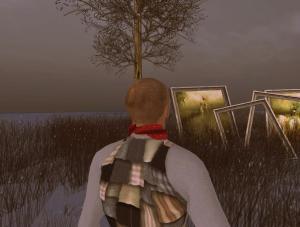
Exploring the beautiful surreality of HuMaNoid on the LEA6 sim
There’s spectacular virtual artwork on display in galleries and fully interactive installations, with whole sims given over to showcasing the fruits of SL designers and builders’ imaginations. There are educational opportunities, music venues, support groups, role-play environments, museums and accurate virtual rebuilds of architecture from antiquity to the present to explore. In my first week back on the grid I went (in avatar) to a summer solstice ceremony (put on by a community of fairies), attended a couple of ‘live’ concerts and hung out at a jazz club. I attended a couple of church services, a meditation group and a storytelling circle (also attended by some imps and fairies). I visited some art galleries and chatted with the artists about their work. I even bit down and went to a writer’s group, which has since become a fairly regular fixture in my weekly calendar.
Here’s an account of how that was for me and my avatar (who is called Klaus, by the way).
The Writer’s Group
A little blue box pops up in the corner telling me that a poetry group is about to start and giving me a teleport link to go there. I check the notecard I picked up in the ‘Written Word’ sim earlier and see that this looks like the kind of thing that I might be able to try – they are going to pick a word and write a poem using it as a starter. I can scribe under pressure, I’ll probably manage.
Teleporting is a little scary, just as it would be in real life.
Once you’ve clicked, you can’t change your mind while it’s happening – and it’s terribly easy to click on a teleport … It doesn’t give you much time to have second thoughts before it dumps you into the destination sim. If it’s busy, you can easily land on one or more avatars in what quite genuinely turns out to be a heap of tangled limbs. You never know what’s waiting for you at the other end – I’ve learned to hover near CTRL+SHIFT+H as Klaus ‘rezzes’ into a new sim, just in case I want to jump out and go home quickly.
Once I’ve landed, I quickly try to move away from the landing area, find a bit of space and get my bearings while the graphics render, which can sometimes take several seconds.
I see Klaus come out of the teleport, a grey shape, falling into a suspended assortment of shattered-glass shards that quickly arrange themselves to resemble modern furniture. There are a few chairs around a table on which there appears to be a tall hourglass shape. People are there already. The other avatars are taking a while to render, so there are wigs of hair and odd textures floating in their places.
I’ve got my ‘avatar impostors’ setting on 3. This helps to speed up the rendering by only fully showing 3 other avatars – the remainder will be shown in outline only, like grey paper statues.
I do my ‘find space after teleporting’ manouvre and get myself wedged behind something that might be a pot plant and something else that turns out to be a wall.
“Hello Klaus” pops up in local chat.
“Welcome Hostarius” pings another greeting.
I realise I must have both my ‘display name’ and my ‘user name’ floating above my avatar’s head so – not for the first time – there’s confusion about how to address me. You either have to switch one of them off, using one of about a gazillion sliders and check boxes embedded in the preferences menu, or quickly let people know what you prefer to be called. I’ve since dropped ‘Hostarius’, not least because he acted like a total noob at a gathering of fairies on day 2.
While I don’t want to be unfriendly, I’m acutely embarassed by my faux pas with the pot plant, and I want to do the whole entry thing again with more dignity.
“Come and join us, we’re going to write a poem,” the host chats.”You’ll need ‘voice chat’ on.”
“I’d love to join you, thank you.” I chat back, discovering that Klaus has managed to find some space again and get out of the corner, but he’s also turned his back on the group and walked away.
I mange to swivel him round, and I see an empty seat at the far end of the table. That’s a relief! The chair could save Klaus from the indignity of making jerky, drunken nooby-avatar moves across the room: if I can just plant a right-click on that chair, it might let me sit on it from a distance.
Success! A right click brings up a wheel menu with the inviting option I’ve come to love: “Sit Here”.
Klaus teleports to the chair. Most of the furniture in SL has built-in scripts that arrange your avatar in a relaxed pose when you sit on it, without you needing to think about it.

Klaus relaxing at home thanks to scripted furniture
Next, I do two things quickly. I snap the camera to front view so that it looks down on Klaus from the front. Mainly I want to make sure he looks okay. The furniture has done its job and seen to everything; he’s settled, even looks like he’s a regular. Directly to his left sits the looming figure of a fox in a battered top hat. Again I’m struck by how much ‘larger than life’ the avatars are in SL. Everyone’s huge. I’ve been at pains to keep Klaus under 6ft, so as not to stray too far over my real life (RL) height, but he might as well be a pixie. It doesn’t matter what he sits on, his feet don’t touch the floor. I’ve since found out that there are communities of ‘normal sized’ avatars on the grid. I guess they exchange notes about how difficult it is to find shoes and furniture that fits.
I may write more about pixies and shoe sizes later. In the meantime, I’m frantically opening up a help page to find out how to turn on and use ‘voice chat’ and clicking through menus in the hope that I’ll get lucky and turn it on by chance.
I manage to activate voice and give it all the permissions it needs to use up even more of my cranky CPU, then turn my attention back to text chat.
Things have moved on. The conversation is about someone known to the rest of the group who has come and gone again in the previous minute, possibly because someone else tried to sit on her. I’m pretty sure it’s not me, but I do chat a quick apology in case I’m sitting in someone else’s chair, and the group proceeds.
Most of the time, the host is doing the talking. She has a soothing, affirmative voice: materteral, unhurried and unharried, but slightly wry. I’m going to realise how very important people’s voices are and the way they use them in this alternative reality. She’s talking to another group member; they are choosing a word by picking a random page in a book, followed by a random verse, line and finally a word in the line.
The host explains for the benefit of ‘Klaus’ that once they have a word they are going to start a timer for 20 minutes and everyone is going to write.
I’m not quite following the process, I’m too busy reading the wiki on how to write a new notecard because I’m assuming we’ll have to share our work at the end of the session by pinging a notecard to the group or something. Notecards are the in-world method for sharing chunks of text.
We have a word …
It’s ‘doom’ – oh dear. We now have 20 minutes to produce the goods. I step away from the screen and go to kitchen to make a coffee and think about ‘doom’.
When I get back, Klaus’ head is drooping onto his chest in the classic ‘away’ pose that avatars assume if their puppeteers become inactive in the window.
I type something in Evernote, planning to paste it into a notecard if I need to. This is a new one on me. I always compose poetry longhand: I’ve never typed a draft directly. There are 7 minutes left on the clock … tap, tap, tick, tock:
DOOM
A point
Of no return
Thick with regret
Turning of locks and
Sliding of bolts and
Everything behind but
The last card on
A dark table with
No pips and
Coming up short
Played out
At the mercy of
No mercy and
A maelstrom of
‘If only’
If only
If only
Time’s up!
It turns out we’ll be going round the circle, reading out our work. The host is careful to mention that each can read if they have something, including ‘Klaus’ if he’d like to. This is what voice is for.
I’ve been on conference calls many a time, and it’s important to take turns when speaking and let the chair person control things. You have to be smarter in SL because there’s text chat ticking along in the background all the time. The official stuff’s happening on voice, in an orderly fashion, each person manually toggling their mics on and off when it’s their turn to speak. An unofficial commentary continues in text chat. This is another thing that takes getting used to, seamlessly switching between typed/read and spoken/heard communication.
We go round the circle. I’m very interested to hear what other people have managed to write – and what their voices sound like.
If I’m honest, this is the bit that has kept me away from real-life (RL) writing groups. I’m not good at being enthusiastic and encouraging if I don’t genuinely like what someone has written and shared. It turns out that’s not a problem with this group; the writing is good. In fact, it’s excellent considering people have only had 20 minutes to draft. Klaus joins in with the applause and commenting with relief, and I feel encouraged by the response to my thin offering.
Then it’s time to hear the original poem from which the hand of fate drew the word ‘doom’ at the beginning of the session. It’s a familiar one to me, “The Deer’s Cry” (aka “St. Patrick’s Breastplate”):
… I arise today
Through the strength of Christ’s birth with His baptism,
Through the strength of His crucifixion with His burial,
Through the strength of His resurrection with His ascension,
Through the strength of His descent for the judgement of Doom …
Well that’s just about it. Ensues the very same awkwardness of saying goodbye and leaving at the end of a meeting in real life when some people seem to be hanging around to chat a bit more. I feel like I’ve done ok, and Klaus will definitely come back here. I chat-type a cheery farewell, hit CTRL+SHIFT+H, and Klaus jumps into the sky, heading home at the speed of pixels.
Where next?
Well, I’d like to go to the ‘Dr Suess Party’ at the leopard lounge … but I’m out of Linden and can’t afford green eggs and ham, let alone a Lorax avatar for the evening!
Filed under: Contemporary Culture, Inspiration, Poems, Poetry, Technology, Writing Tagged: Arts, Community, Creative Writing, Creativity, Fantasy, Poetry, Second Life, Social media, Social Networks, Virtual Reality, Writing


April 11, 2015
Modern insomnia
Actually this didn’t happen last night. It could have happened very easily, but then I wouldn’t have been up early and drawing it — so that I could post it on Pinterest. Oh, the circularity!
Filed under: Contemporary Culture, Miscellanea Tagged: Doodles, Humour


April 4, 2015
Ten Mandalas
I started playing around with mandalas last August, using them to bring focus and form to my life after a fairly chaotic summer of dropped habits and too many new things to process.
They also gave me the opportunity to try different techniques like drawing, painting, photography and photoshop.
I have ten now, and I’m thinking of continuing the project in moments of leisure. Each of them is fairly personal, a visual prayer or meditation, or an attempt to create a sense of order from disparate ideas.
I’m cautious of sharing these with too much explanation. The whole point of them is to transcend words alone and I prefer to leave the looker to find their own thing to take away. I’ve just limited the words to a title and an epithet.

Potential: life is finite, but the possibilities are infinite

Voyage: be the wind in these sails …

Resurrection: unless a grain of wheat dies and falls to the earth it remains just one grain
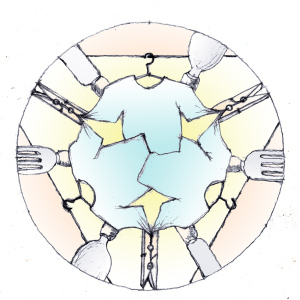
Commonplace: the laundry, the cooking, these are my sacraments

Change: for everything there is a season
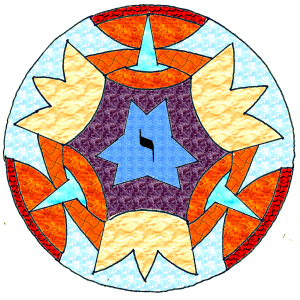
Epiphany: field and fountain, moor and mountain

Fruitful: my hedgerows of plenty must always be free

Industry: work is doing real stuff
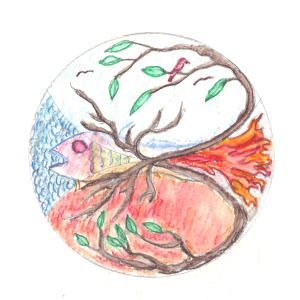
Elemental: Solvite Corpora Et Coagulate Spiritus

Dwelling: inhabit, reside, abide, nest, occupy, rest, roost, settle, sojourn
Filed under: Art, Inspiration, Symbolism Tagged: Creativity, Journaling, Spirituality

March 20, 2015
A Post for the International Day of Happiness
I’m 15 years old, a schoolboy, and I’m walking onto a patch of light cast in a school courtyard by a street lamp.
The tarmac is black, the light is yellow and I’m seeing both colours simultaneously from the same surface. I register the matter of one and the energy of the other with no sense of duality. Perhaps that is what cuts me free for this moment in time. Because suddenly I have a taste of something for which there is no name: ‘contentment’, ‘awareness’, ‘union’ or ‘bliss’ could be used clumsily.
Maybe it’s just that I actually feel ‘happy’, and this is the new definition for that word.
I imagine that a bit of dust is caught in the groove of my life, causing the needle to skip back and replay those ten steps I take through the light, again and again, forever – it would be enough for me.
I am aware of other things that make the moment perfect. It is not anticipated or sought after, and it has not been added to by memory.
My shoes have rhythm – I wear black lace ups like Fred Astaire – and my limbs are supple and relaxed. This patch of light is triangulated upon three loci that are especially significant to my coagulating sense of identity: bordered on one side by the churchyard wall, a stone’s throw from the parish church, 50 paces from the school theatre and 30 paces from the English department. I belong here; this is my territory.
Place and time have come together. I am the lord of the night air and the emperor of this pool of light. I spin around on my heels, walk backwards for a few paces, rejoicing.
The dark receives me again and I walk on, down the hill towards the boarding house.
 Moments that are impossible to recreate, unasked-for, not divorced from the past or the future but somehow complete in the present, as if some prankster balanced a bucket of grace on the lintel of a doorway and I was the fool that got drenched – I think this is how happiness is for us.
Moments that are impossible to recreate, unasked-for, not divorced from the past or the future but somehow complete in the present, as if some prankster balanced a bucket of grace on the lintel of a doorway and I was the fool that got drenched – I think this is how happiness is for us.
About twenty years later, I’m lying in bed.
I’m constructing the argument I should have made earlier in the day during a conversation. It feels water tight. I’ve started with a couple of ethical givens and I’m going through the logical steps to my conclusion.
But the steps are also taking me to the edge of sleep, and suddenly I’m there, toeing the border line. My internal dialogue stops but it’s as if I step onto the platonic form of all arguments in all times and places and continue. Vividly in my mind I see a ruler stretching over an abyss and a dividing compass pacing along it.
When the compass gets to the end of the ruler, I see something else that lasts for a couple of seconds. It’s like the dot of light that would shrink and disappear in the moments after turning off an old television set. But I see it with my whole being, as if my mind has become a single organ of sight.
In that moment, I KNOW all the answers to everything: all paradoxes and problems that have befuddled humans for millenia. I have the answer to the problem of evil, the resolution of determinism vs. free will, the goal of every koan, the last word on why we are here at all. I feel what it’s like to be omniscient for the tiniest sliver of a moment, and then it flits away into the abyss.
I pull myself back into wakefulness to see if I’ve been able to retain any of the knowledge, but the moment was too short for my memory to turn it into brain-code and store it. Nevertheless I feel a soaring sense of contentment. It’s enough for me to know that the answers DO exist and that they are real.
The afterglow of that revelation lasts to this day.
May this International Day of Happiness for you be booby trapped with unsolicited delight.
Filed under: Inspiration, Miscellanea Tagged: Nostalgia, Spirituality

March 7, 2015
Reviewing a few recent reads
I’ve started 2015 trying to finish reading a few books that have been on my ‘current’ shelf for too long, and I’ve set myself an ambitious reading list for the year. I’m also trying to revive the discipline of writing a brief personal response on finishing a book.
While I have still not decided what to say about Whitman’s ‘Leaves of Grass’ (which it feels almost sacrilegious to comment on) and Giordano Bruno’s ‘De Umbris Idearum’ (which I probably need to re-read), or how to comment best on a couple of – excellent – books authored by friends of mine, I’ve found something to say about some other recent reads.
 The Complete Illustrated Stories of the Brothers Grimm by Jacob Grimm
The Complete Illustrated Stories of the Brothers Grimm by Jacob Grimm
My rating: 2 of 5 stars
One of the few things I can conclude from this book is that neither the brothers Grimm nor the good people who narrated these tales to them were sober at the time. That doesn’t negate the work as a pretty extraordinary record of the dark, moralistic, occasionally humorous but rarely original landscape of 19th century German folklore.
Grimm seems to be back in vogue at the moment, in Hollywood, in fresh anthologies of fan fiction, in a counter-movement to ‘disneyfication’. Many of these tales certainly beg to be retold and made relevant in our day. Some of them are downright funny and have great punchlines. A few of them provide novel variations on stories we think we know. Most of them simply recombine the same tropes like cards drawn at random from a deck of superstitions.
In the world of Grimm you must be kind and generous and it’s even more to your credit if you are poor; beautiful people are good and ugly people are evil; you should avoid forests and bodies water, especially if you are a child; you can generally trust elderly people; women are either barren or remarkably fecund; children should respect their parents and compete against their siblings for their affection; parents shouldn’t spoil their children; life is pretty cheap; cunning always prevails against brute force and being a smart arse is admirable. Given how much these values are at odds with those of the 21st century I’m at a loss to explain the revival of interest …
 Descent of the Dove by Charles Williams
Descent of the Dove by Charles Williams
My rating: 3 of 5 stars
Charles Williams’ take on Church History: I found it much harder to understand than his book “Witchcraft”, which feels rather like a companion to this work. Nevertheless, I glimpsed much through the shifting clouds of his prose, and what I saw, I liked. Williams does this in his fiction as in his non-fiction: he sees the whole of reality in a different way and hardly bothers to spell it out for his readers. You sort of go along for the ride and the stuff he says about the passing vistas makes you see them as he does for a few breathless moments that seem to invoke a Jungian sense of ‘oneness’.
On discovering huge gaps in my understanding of classical thought, literature and history, I have only been provoked to read more and explore further. Centrally, though, I’m broadly comforted by Williams’ essential recasting of the bloody, shameful and dark moments in Christian history. His vision enables him to discern God at work in diverse and contradictory movements, frequently pitted against each other. Central to this is his unique theological formulation of ‘co-inherence’ – that process by which humankind incubates the Kingdom of God.
There is a lot of assumed knowledge he expects in his readers, which makes some parts of the text almost inaccessible to those outside the orbit of his intellect (including me). However, a bit of background in Williams’ theology, namely the formulations of co-inherence and the ‘Way of Affirmation’ versus the ‘Negative Way’, will open up much of this to a new reader, as will a prior reading of Dante’s ‘The Divine Comedy’.
I will strive to be equal to a second reading of this book when I come to it, and in the meantime I have copied out a good few of Williams’ perfectly turned phrases to chew on and extended my reading list for the coming year.
 Chaos: A Graphic Guide by Ziauddin Sardar
Chaos: A Graphic Guide by Ziauddin Sardar
My rating: 3 of 5 stars
Before reading this book, all I knew about chaos theory came from reading Douglas Adams’ Dirk Gently novels back in my teens. After reading it, I don’t feel as if I know a great deal more. Obviously chaos is hard for a non-mathematician to fathom, and this book needs a rudimentary grasp of a lot of related concepts which it only mentions.
It does a good job of surveying the history and development of chaos theory with specific reference to the important pieces of research and the people who published them. All the ways that chaos theory touches into economics, biology, physics, engineering and other fields is given a broad treatment.
As I tried to wrap my mind around the text, it would have been helpful to have some diagrams – it’s a ‘graphic’ guide after all. But the illustrations were abstract and pretty unhelpful. They consisted mostly of collage-style cartoons of people with romano cabbages instead of hair, interacting with scribbly representations of strange-attractor curves and a model chart of fish population growth. I can see how the gradual incorporation of different elements in the collages reflected the addition of new concepts as the book progressed, but they didn’t really shed new light on the topic. It feels like a missed opportunity to clarify things with good graphic material. ‘Strange attractors’ seem to be really important to the whole thing, but I felt that they were glossed in the early sections and still don’t quite get it.
However, I managed to grasp the stuff on fractals, time, turbulence, markets and there were a few moments when the penny dropped in spite of the brevity of the text and the obscurity of the illustrations. I have also found my awareness of chaos has expanded and I’m more likely to spot it at work and factor it into the way I see the world around me – this is a good thing. I have another book in the series – on fractals specifically – to read next, and I’m looking forward to it.
 A Friend in Every City – One Global Family – A Networking Vision for the Twenty First Century by Penny Power
A Friend in Every City – One Global Family – A Networking Vision for the Twenty First Century by Penny Power
My rating: 3 of 5 stars
Although it was published in 2006, and social and online business networking has moved on very rapidly since then, there are still many useful parts in this book. Plenty of it’s predictions have come true and the overall vision of a global family is still working itself out.
I read it partly as an interesting documentary on the state of social networks back in the days when they were less populated, and partly as a handy guide to the practicalities of networking. Advice on setting up profiles, branding, developing an open and generous attitude (rather than only selling) and the bits on team and personality profiling were all good to chew on.
Lots of case studies and stories keep the interest going, but it has dated quite a lot in the last 7 years.
View all my reviews on Goodreads
Read my more in-depth review of Richard Crompton’s ‘Hells Gate’ over at Orion Fiction’s Murder Room blog.
Filed under: Books, Reviews Tagged: Reading

January 11, 2015
A glyph for 2015
Over the last couple of years, my way of processing life and pondering the world around me has increasingly been mediated through symbols. Writing systems, pictograms, allegories and icons are the currency of my imagination. With symbols I can do more than words allow. I have a developed a personal pictography, a kind of shorthand, drawing from many sources and referenced to particular meanings.
I’m well past making new year’s resolutions but I’ve always taken time to focus on taking stock of the passing year and feeling out the themes of the coming year round this time. In prayer and contemplation for 2015, it seemed three things and a fourth were being emphasised.
Having worked out glyphs for these emphases, I noticed that each of them had a common element – a cross – enabling me to combine them into a single form.
So here is the glyph I mark upon the doorposts of 2015.
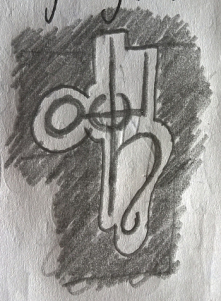
2015
It’s component parts are thus:

Finishing
Finishing
This is the symbol for Saturn. In esoteric systems, Saturn has a very complex variety of correspondences. But, to keep it simple Saturn was the Greek god of agriculture and the symbol contains two elements: a cross (or sword) and a sickle. It can be taken to represent the harvest: things must die and come to an end but in that moment seeds are gathered for sowing in the next cycle.
Of course, to be saturnine is to be gloomy, but, to borrow from the Christian imagery of the cross, the words of the Son of God are appropriate.
“I assure you: Unless a grain of wheat falls to the ground and dies, it remains by itself. But if it dies, it produces a large crop.” (John 12:24 HCSB)
I’ve noted that the last few years have been characterised by a lack of finishing. I enter 2015 with so many projects begun and not completed. An unfulfilled intention, a work half done, can become rotten. I need to put the sickle in and finish many things so that new life can come. 2015 is to be a year of finishing.

Truth
Truth
Encapsulated here in one of the many alchemical symbols for gold is something I need to bring back to the centre. Truth, like gold can be tested by fire, bears no combination with other elements and stays unchanged.
I’m a people pleaser. This means I all too easily try to give others the answer I think they want to hear. That’s not always realistic. I’ve a creeping habit of white lies: “Of course, it’s no problem.” “I’ll be there at six.” “It will be fine.” “I’ll be thinking of you.”
These are not loving, respectful interjections unless they are true. Even if it arises from the best will in the world, I need to curb my optimism at times and let my ‘yes’ actually mean ‘yes’.
“Truth, like gold, is to be obtained not by its growth, but by washing away from it all that is not gold.” (Leo Tolstoy)

Praxis
Praxis
This is a symbol I’ve invented to use for the concept of praxis – an antidote to inwardness. It depicts a sword, internally rooted but driving outwards to act externally. For me, Praxis doesn’t oppose contemplation but means something like a ‘contemplation by doing’ and it’s closely allied to the philosopher’s ‘techne’ – practical craft.
I owe this new emphasis to the lessons I’ve been studying in alchemy over recent months. The alchemist performs processes – burning, boiling, distilling – all the while observing diligently the transformation of substances without missing the correspondences with his own soul-work.
I’ve written before in this blog on the experimental approach to life, and this seems to be back in focus for this year.
It’s surprising I never really took to science at school. I don’t think I ever made the connection between what we did in the classroom and the fact that my den in the garage hosted a fossil collection and pendulums that hung from the ceiling to study gravity and waves. I had exercise books full of notes and measurements of such things as the landing positions of sticks thrown at random. I tried to replicate the experiments of Mendel in my flower bed. I was just a little Issac Newton, but schooling cast me as an ‘arts person’.
I don’t think our education system encourages the formation of a renaissance mind, and more is the pity.
In 2015 the world and my self will be my laboratory. I want to do real stuff in the real world and watch it closely and learn all I can from it instead of from books.
And the fourth thing
Although not depicted, this underpins all of them. It’s ‘momentum‘.
I’m poor at keeping momentum. If things are going well, I cruise or put my attention elsewhere, so they grind to a halt. This goes for creative projects, relationships, work and home life. Things are not finished. Wishful thinking swallows up reality. Praxis collapses back into theoria.
It’s easier in the long run to keep the wheels turning with tactical doses of effort than to be repeatedly frustrated by inertia.
Filed under: Art, Inspiration, Symbolism Tagged: contemplation, Creativity, Doodle, Journaling, Knowledge Management, Spirituality, Time management, Tools

December 12, 2014
The Secret Language of Twigs
I think we could all learn a lot from the Double Rainbow Guy. If you’ve not seen and heard his now famous three and a half minutes of ecstasy, click and watch it NOW.
Listen carefully as he sobs: “What does it mean?”
Just like the rest of us walking upright on this planet with large brains, and suffering wisdom teeth and the threat of appendicitis, for Rainbow Guy (aka Yosemitebear) a rainbow is never just a rainbow. It has to mean something. Stories are fables, and planets are gods and goddesses, and homes are castles, and every picture tells a story, and a girl tucking a wisp of hair behind her ear actually fancies you.
Our tendency to attribute meaning makes life rich and it makes us human. We must allow ourselves to be in dialogue with everything our senses encounter. I think philosophy has big words for this kind of stuff: existential phenomenology, personal mythos, cosmogony… but let us be spared them as I unfold ‘the secret language of twigs’.
A man that looks on glass,
On it may stay his eye;
Or if he pleaseth, through it pass,
And then the heaven espy.
(George Herbert)
My dog loves sticks. She also happens to be one of my most trusted spiritual directors. Many are the things I’ve learned in her company. I thought perhaps I should take her fascination with sticks more seriously.
At first I noticed how different species have distinctive ways of growing that give rise to endless variations within the parameters of their genes. The elder speaks with one set of forms, and the beech with another. And then, a whole world opened up to me that means walking in the woods will never be the same again.
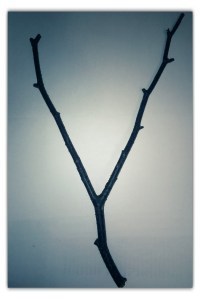
Beech
Divided Way - The most common and fundamental form of branch. Growth divides and divides again to the left and right. Even choosing not to make a choice is itself a choice.
A choice! Do you, my listener, know how to express
in a single word anything more magnificent? Do you realize,
even if you were to discuss year in and year out how you could
mention nothing more awesome than a choice, what it is to
have choice! For though it is certainly true that the ultimate
blessing is to choose rightly, yet the faculty of choice itself is still
the glorious prerequisite.
(Soren Kierkegaard)
The top of a wayfarer’s staff often has a fork in it; how many times must a traveller decide between two paths?
Flip it over and you have a confluence of two ways. I’m more aware of divergence than confluence in life. The latter happens so quietly but suddenly you find that someone else is with you, or two creative ideas have joined to make a third.

Elder
The Third Way – lest we forget that choices are not always ‘either/or’. If I find myself trying to decide between two things, the question I often forget to ask is: “Is there a third way?”
I don’t mean a ‘middle way’, but there’s almost always another option that evades us when we are double bound and damned if we do or don’t do one thing or another.
Other people often present us with an either/or, forestalling our capacity to step back and think creatively whether there’s a potential we’ve missed. That third way may even be to do nothing.
We also have here the footprint of a bird, a creature of the air that has come down to feed on a creature of the earth (a worm). Earth is marked by its feet in a way that air is never marked by its wings … ponder this.

Ash
The Bow - sacred in human culture from our hunter-gatherer ancestors onward and right across the face of the earth: for hunting, making war and making music.
In the Bible, when God attributes meaning to the rainbow, the original language refers to her ‘battle bow’.
I do set my bow in the cloud, and it shall be for a token of a covenant between me and the earth.
(Genesis 9:13)
It foretells the hope that the instruments of war will be beaten into plowshares and become tools for nurture instead of destruction.
In numerous mythologies, the heavenly bow is a bridge between the sphere of mortal struggle and the paradise of rest and peace. In Bantu cosmology, it is created by the dance of seven snakes. So, once again, Yosemitebear is not such a fool.
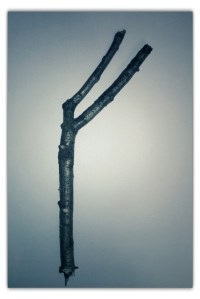
Beech
Fe - the first rune of the ancient scandanavian ‘futhark’, signifying wealth and plenty.
‘Wealth’ meant something very different to the inventors of the runic alphabets. It was probably quantifiable in cattle. While we owe a lot of our letter shapes and sounds to these forebears, we may have lost their understanding of wealth. Mine is a number on a screen that pops up after I’ve typed a few passwords and memorable numbers on a keyboard.
When this twig cracked under my foot it seemed to shout in twig-speak: “We are wealth! We are woods, and water, and weather! Wait and listen!” So I did. And all I could hear in the the trees was this: “Ffffffffffffffffffffffffffffffffffffffffff…” – a continuous whisper of plenty.

Hazel
Vav – the sixth letter of the Hebrew alphabet, whose pictographic meaning is ‘hook’ or peg. Curiously its equivalent in our alphabet is also … ‘F’ – both in sound and numerical value.
As the very simplest single stroke of a pen or brush, this letter shape has been associated with one-ness and, as a sinuous curve from top to bottom, it has also been taken to represent the flow of revelation from heaven to earth.
Without needing to go down a kabbalist rabbit hole, I’ve found this form deeply appealing since the moment I tried to create it perfectly with a calligraphy pen several months ago.
I think the idea of ‘unity’ encompasses its meaning very well: flowing together, once again, between air and earth, my feet of clay and my wings of aether. All that I do belongs to flying or digging and the art of living is to do both at once: to pray as I work.
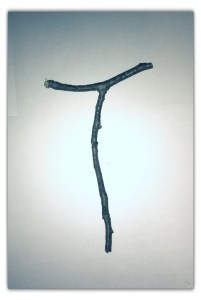
Alder
Tau – 19th letter of the Greek alphabet, final letter of the Hebrew alphabet.
Saint Francis used this (the Tau cross) as his signature and it is fitting that this little alder twig should say his name to us, because he called the Sun his brother and the Moon his sister and was mindful of all living things.
For this reason I have a slight preference for this as a sign of Christ’s cross over the traditional form (which all too readily becomes a sword). This is the final letter, the end of present tyranny and the reconciliation of the whole created order.
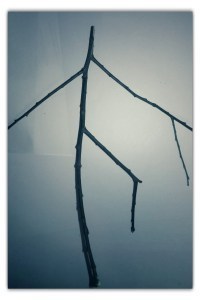
Unidentified
The Dancer - let the trees of the field clap their hands!
Not only did I find this exultant shape in the woods but it also looks very similar to the lines on my left palm, where I recently discovered the stick figures of two dancing people.
Maybe I’ll show them to you one day. But I’d like to end this epistle of the woods and hedgerows with a few words from the bard himself:
Now, my co-mates and brothers in exile,
Hath not old custom made this life more sweet
Than that of painted pomp? Are not these woods
More free from peril than the envious court?
Here feel we but the penalty of Adam,
The seasons’ difference; as, the icy fang
And churlish chiding of the winter’s wind,
Which, when it bites and blows upon my body,
Even till I shrink with cold, I smile and say
‘This is no flattery: these are counsellors
That feelingly persuade me what I am.’
Sweet are the uses of adversity,
Which like the toad, ugly and venomous,
Wears yet a precious jewel in his head;
And this our life exempt from public haunt,
Finds tongues in trees, books in the running brooks,
Sermons in stones, and good in every thing.
I would not change it.
(As You Like It, Act 2 Scene I)
If you enjoyed this, you might like to read more of my ‘Wisdom of Things Found’ posts:
The Wisdom of Things Found
The Pageless Book
Root Man
The Clarinet Reed
The Eraser
Filed under: Inspiration, Things Found Tagged: Creativity, Nature, Spirituality, Storytelling

November 3, 2014
Neologism Diarrhoea
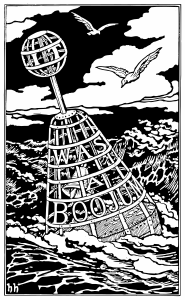 Although this is supposed to be a ‘writers blog’ it tends to be a repository for the things I don’t write: the stuff I do when I should be writing. When I do find the time to actually do some writing (for myself), I often find all my brain wants to do is mess about and compose nonsense. I find this incredibly easy and profoundly satisfying.
Although this is supposed to be a ‘writers blog’ it tends to be a repository for the things I don’t write: the stuff I do when I should be writing. When I do find the time to actually do some writing (for myself), I often find all my brain wants to do is mess about and compose nonsense. I find this incredibly easy and profoundly satisfying.
Really, ‘nonsense’, of the sort that Lewis Carroll and Edward Lear gave us, leaves a much wider space for readers or listeners’ imaginations to play in. It harps upon this beautiful feature of human languages: with syntax, sound and context we are more than half way to understanding meaning. Who the hell needs vocabulary?
I give you, therefore, ‘The Toast of Far Gelar‘.
If you like this sort of thing, you might enjoy listening to my story, The Jellyfarglemarsh, at Stories from the Borders of Sleep.
Filed under: Inspiration, Miscellanea, Poems, Poetry, Spoken, Writing Tagged: Creative Writing, Fiction, Grammar, Humour, Poetry, Writing






